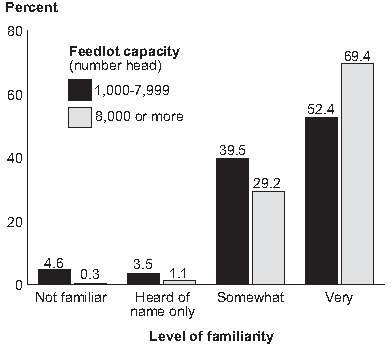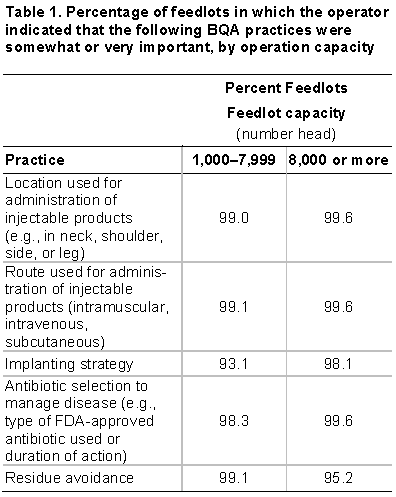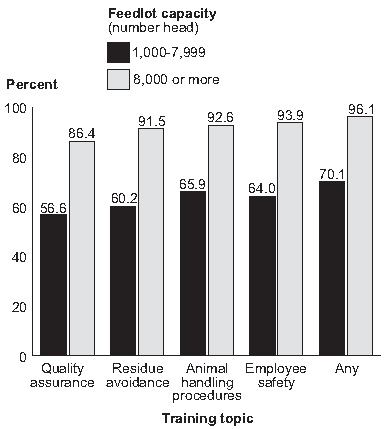



Quality Assurance in US Feedlots
The Beef Quality Assurance (BQA) program is a State and national industry-led effort that provides guidelines to support the production of quality beef. The goal of the program is to raise consumer confidence in beef quality through recommended management techniques and a commitment to quality within segments of the beef industry, including feedlots.Guidelines included in a
BQA program focus on issues that include feedstuffs,
feed additives and medications, processing and
treatment records, injectable animal health products,
care and husbandry practices, and guidelines for the
general care and handling of cattle. Participating in the
BQA program can help ensure that quality beef reaches
consumers through safe handling, feeding, and care of
cattle. Improvements in cattle care and health will
undoubtedly increase the quality of beef for consumers.
In addition, the BQA program helps to improve food
safety and support animal welfare and well-being, major
concerns of consumers. The use of the BQA program
can positively impact all that are involved, including
cattle, feedlot operators, and consumers.
The US Department of Agriculture’s National
Animal Health Monitoring System (NAHMS) conducted
the Feedlot 2011 study, an in-depth look at large
feedlots (1,000 head or more capacity) in 12 States2
and small feedlots (fewer than 1,000 head capacity) in
13 States.3
Large feedlots accounted for 82.1 per cent of the
January 1, 2011, inventory of feedlot cattle in all US
feedlots but only 2.8 per cent of all feedlots. The 12
participating States accounted for over 95 per cent of the
inventory of cattle in large feedlots (NASS, “Cattle on
Feed” February 18, 2011). Small feedlots accounted for
16.0 per cent of the inventory on all US feedlots and
92.9 per cent of all US farms with cattle on feed. The 13
participating States accounted for 85.4 per cent of US
farms with fewer than 500 cattle on feed and 90.5
per cent of the inventory on farms with fewer than 500
cattle on feed (NASS, 2007 Census of Agriculture).
Study results presented in this information sheet reflect
only large feedlots,4 which were divided into two groups: those with a capacity of 1,000 to 7,999 head and those
with a capacity of 8,000 or more head.
Familiarity with the BQA program
An objective of the Feedlot 2011 study was to describe feedlot operators’ familiarity with the BQA program and to describe management practices that may impact beef quality. Widespread awareness of the BQA program has been a goal of the beef industry for several years. Operators on 52.4 per cent of feedlots with a capacity of 1,000 to 7,999 head were very familiar with BQA program, compared with operators on 69.4 per cent of feedlots with a capacity of 8,000 or more head (figure 1). Overall, only 4.6 per cent of feedlots with a capacity of 1,000 to 7,999 head and 0.3 per cent of feedlots with a capacity of 8,000 or more head had operators who were not familiar with the BQA program.

Importance of BQA practices
Operators on over 9 of 10 feedlots, regardless of capacity, indicated that each BQA practice listed was somewhat or very important (table 1). Clearly, there was widespread agreement on the importance of BQA practices.

Training for BQA practices
Seven of 10 feedlots with a capacity of 1,000 to 7,999 head (70.1 per cent) had formal training programs for employees on one or more of the listed BQA practices, compared with nearly all feedlots with a capacity of 8,000 or more head (96.1 per cent) [figure 2]. This difference could be due to the smaller number of employees on the lower-capacity feedlots, leading the operators and owners to assume that a formal BQA training program is unnecessary.

Summary
These data suggest that feedlot operators,
regardless of feedlot capacity, are aware of BQA
programs and believe that the programs are an
important aspect of running an operation. Continuing
outreach through training programs, seminars, and other
methods is important to maintain and advance support
for the BQA program.
2 Arizona, California, Colorado, Idaho, Iowa, Kansas, Nebraska, New
Mexico, Oklahoma, South Dakota, Texas, Washington.
3 Illinois, Indiana, Iowa, Kansas, Michigan, Minnesota, Missouri,
Nebraska, Ohio, Pennsylvania, South Dakota, Texas, Wisconsin.
4 Information on small feedltos is available at:
http://www.aphis.usda.gov/animal_health/nahms/feedlot/index.shtml


